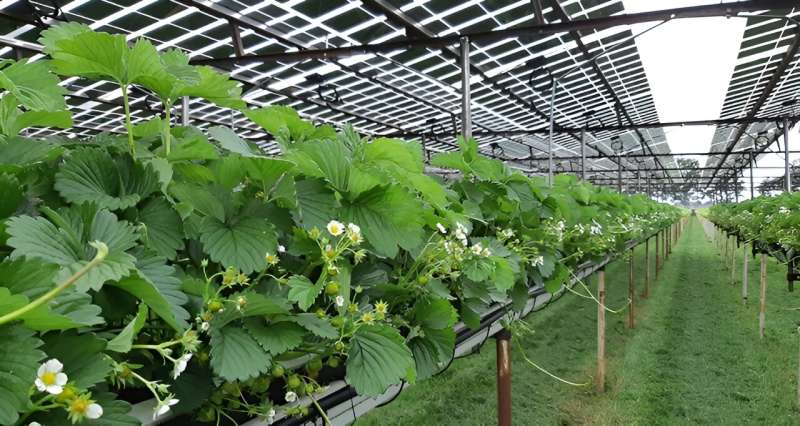This article has been reviewed according to Science X's editorial process and policies. Editors have highlighted the following attributes while ensuring the content's credibility:
fact-checked
trusted source
proofread
Researchers see a future for agricultural solar parks, but also challenges

Solar parks and agriculture do not have to be placed on separate fields. It is possible to combine both functions on the same field, researchers from Wageningen University & Research and Renergize Consultancy write in their position paper "Producing food and electricity on the same square meter." Researchers see a future for agricultural solar parks, but also challenges. This new concept provides opportunities, but also requires new knowledge as well as modified legislation and regulations.
Until now, solar parks in the Netherlands have almost always been monofunctional. The land is then used only for power generation. This has resulted in increasing societal opposition due to the inefficient use of space. Government policy also requires plots intended for energy generation to fulfill multiple functions.
One possibility for this multi-functional land use is combining agriculture with solar panels. This results in agricultural solar parks, also known as agri-PV. Examples include rows of vertical solar panels with grass or potatoes between them or partially transparent solar panels above fruit trees or berry crops.
In the position paper, researchers from Wageningen University & Research and Renergize Consultancy conclude that large-scale production of food and power on the same field is indeed possible.
Although crop yield and power production per hectare may decrease somewhat compared to the situation where the land has only one function, the combined yields per hectare with agri-PV are higher than crop cultivation and power generation on two separate fields. For example, research with several crops in Germany showed that the production of 1 hectare of agriculture and 1 hectare of solar park—thus 2 hectares in total—can be achieved on only 1.25 hectares with agri-PV.
Not only benefits
Nevertheless, more efficient land use does not always lead to a viable business case. "The focus on efficient land use is too narrow," says WUR researcher Frank de Ruijter, co-author of the position paper. An agri-PV setup is more expensive than a regular solar farm, and the additional costs have to be earned back somehow.
For the farmer there can be advantages and disadvantages. On the one hand, a solar cover can provide protection during extreme weather; on the other hand, the shade created by the agri-PV system may result in a reduced harvest.
To maximize both crop and energy yields, solar panels need to be adapted to the crop being grown, and sometimes changes in crop cultivation method are required. The researchers expect to acquire more knowledge on these aspects in the coming years. In addition, for large-scale roll-out of agri-PV, legislation should establish clear guidelines for agricultural solar parks.
Due to the higher investment in agri-PV, the researchers also recommend a dedicated tariff for agri-PV within the subsidy schemes for large scale solar projects. Moreover, because the land in agri-PV continues to be used for agriculture, all rights and obligations associated with agricultural land must remain in force, such as the Common Agricultural Policy (CAP) and fertilizer application rights.
More information: Producing food and electricity on the same square meter: edepot.wur.nl/639135
Provided by Wageningen University




















